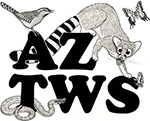
- This event has passed.
ASU: Northern Mexican Gartersnake Thesis Defense
February 27, 2017 @ 3:00 pm - 5:00 pm
Free
Microhabitat and Movement Assessment for Northern Mexican Gartersnakes (Thamnophis eques megalops) at Bubbling Ponds Hatchery, Arizona
Presenter: Tiffany Sprague
Committee members: Heather Bateman, Stan Cunningham, Thomas Jones, Erika Nowak

Species conservation and effective research study design require an understanding of the habitats on which that species depends as well as how it moves within and among those habitats. Bubbling Ponds Hatchery in Cornville, Arizona, supports a robust population of the northern Mexican gartersnake (Thamnophis eques megalops), which was listed as threatened under the Endangered Species Act in 2014. Natural resource managers are interested in understanding the ecology of gartersnakes at this site to guide hatchery operations and to serve as a model for habitat creation and restoration. This study identified habitat selection and activity patterns of northern Mexican gartersnakes at the hatchery and how frequency of monitoring affects research results. Gartersnakes exhibited seasonal variation in habitat selection and activity, selecting wetland edges and moving longer distances during the active season and being less mobile and selecting upland habitats during the inactive season. Frequency of monitoring influenced robustness of results, with less-frequent monitoring providing only 53–62% of known daily distances traveled during the active season. Conservation of this species should incorporate a landscape-level approach that includes abundant wetland edge habitat with connected upland areas. Resource managers and researchers should carefully assess timing and frequency of activities in order to meet project objectives.
February 27, 3:00 p.m.
Arizona State University Polytechnic Campus, Peralta Room 145
